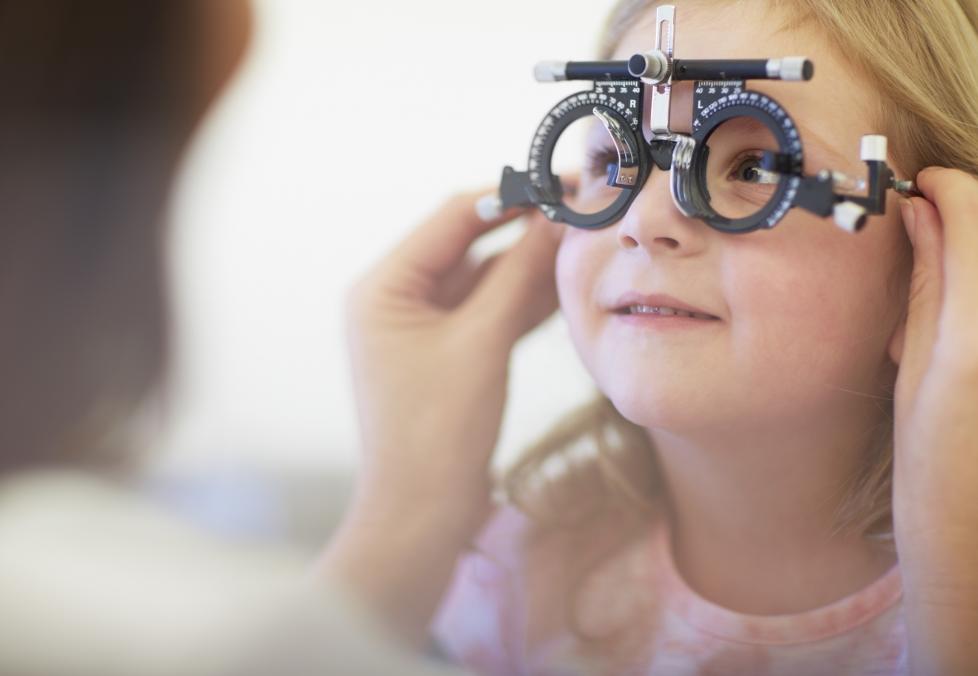
Treat your eyes to a free quality eye exam with our popular two-pair offer.
Everything you need to know to take care of your eyes — for life.
Is your child’s world a blur? Watch for these warning signs that it’s time to book an exam.

Some kids recognize that they have trouble seeing. Others have no idea—until the right prescription puts the world into focus for the first time.
Deanna Paul-Blanc, O.D., a Nashville–based optometrist with Nashville Regional Eye Care, located inside an America’s Best Contacts & Eyeglasses, recalls the time a mother brought her 7-year-old son in for an eye exam. The boy had no vision complaints, though his mother had noticed him squinting.
Turns out, he needed a prescription of -3.0, which is significant for a child that young. When Dr. Paul-Blanc adjusted the machine to the correct prescription, the boy jumped out of the exam chair and began enthusiastically repeating, “I can see! I can see!”
Children born with poor vision may believe that’s how everyone sees, so they don’t think to speak up. Others just aren’t wired to complain or draw attention to themselves.
That’s why routine eye exams are important. They can pick up problems when you and your child can’t. Dr. Paul-Blanc recommends booking a first eye exam before your child starts kindergarten, and then every one to two years from then on.

Treat your eyes to a free quality eye exam with our popular two-pair offer.
Even if you’ve crossed that off your to-do list, watch for the following warning signs that something’s not right with your child’s vision. If you notice any of them, call an eye doctor and book an appointment.
Did you know that kids with vision problems should get their eyes checked every year? Now's the time to book an appointment! Click here to find an appointment time that fits your schedule.
Trouble seeing far away (nearsightedness, or myopia) is the most common vision complaint in schoolchildren. And struggling to read a whiteboard at the front of the classroom is an early tipoff.
At home, your child might park himself thisclosetotheTV—and continue to scooch up no matter how many times you tell him to move back.
On the flip side, if your child seems to get headaches whenever he reads, or if he sometimes holds his iPad or books unusually far away from his face, he might be farsighted (hyperopia).
Remember Dr. Paul-Blanc’s patient who’d been squinting? This reflex is a common go-to fix for anyone who’s having a hard time seeing a crisp image.
When you squish your eyelids close together, you’re forcing incoming light to aim directly at the retina. The temporary change in the eye shape helps you see a bit better.
It’s normal for kids to lean their head when they’re watching TV or they’re tired. A much more deliberate and persistent head tilt to one side, however, could be your child’s attempt to adjust his visual angle to see more clearly.
Head tilting can also indicate crossed eyes, a common condition in kids. That’s when the eyes aren’t lined up properly, causing one to become weaker. Eventually, the brain learns to ignore the image from the weaker side.
Another concern here is lazy eye, or amblyopia—the most common eye disorder among children. This is when one eye doesn’t work with the other, turning in or out on its own.
Both can become permanent vision problems if corrective steps aren’t started soon enough.
Unless your child is pretending to be Captain Blackbeard, covering one eye to read or concentrate is a telltale sign that one eye has much poorer vision than the other, known as a refractive amblyopia.
“The child will subconsciously cover that bad eye to see better with the good eye,” Dr. Paul-Blanc says.
If your early reader begins to quickly tire after cracking open a book, or if she can’t recall what she just read, her eyes might be having a hard time working together during up-close tasks.
When we read or perform other near tasks, our eyes pull in toward each other—called convergence. But if the eyes can’t do that, double vision or blurriness can occur.
“At the end of a paragraph, they’ll have no idea what they just read, because they were concentrating so much on focusing,” explains Dr. Paul-Blanc.
The disorder can be missed during a routine eye exam, so if there’s a concern about reading progress, ask your eye doctor to test your child. Eye exercises can improve the condition.
If your child does this, chances are it’s just how she was taught to read. “But some kids have to do it to hold their place because their tracking muscles aren’t working efficiently,” says Dr. Paul-Blanc. Their eyes don’t follow left to right or top to bottom smoothly, jumping forward and back so slightly that it’s hard to notice.
It’s a cute Instagram moment when kids rub their sleepy eyes. But doing it excessively throughout the day could be a subconscious way of trying to make things clearer. An unusual amount of blinking can mean that too.
Allergies are another thing you may want to check for here—especially if the eyes are also inflamed, itchy, and red. Your eye doctor can help diagnose and treat an eye allergy.
Most kids aren’t Derek Jeter. But if your child’s trying her hardest at a sport with little to no improvement—she can’t catch, she always swings late at pitches, or she’s clumsy on the field—poor vision may be to blame.
She may also struggle with depth perception (judging distances), following a moving object, or seeing out of the corners of her eyes.